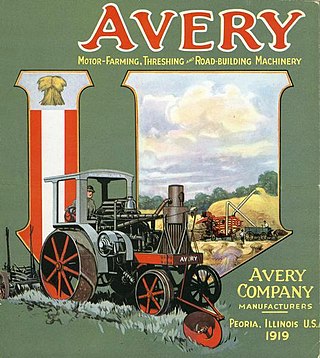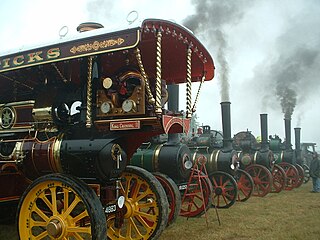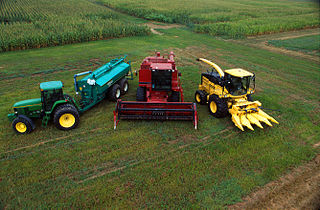WMSTR, or the Western Minnesota Steam Threshers Reunion, is an annual, non-profit "steam meet" held in the small town of Rollag, Minnesota. It takes place over the weekend of the US Labor Day holiday (first Monday in September), and draws around 80,000 visitors during the four days of the event.
Beginning in 1954, the reunion has grown from a few farmers threshing grain, as their fathers had, to one of the largest steam venues in the nation. Antique and steam tractors and automobiles are featured.
WMSTR is a living museum and as such, all exhibits are expected to be operable. One of the most popular, visible, and amazing attractions is the SOO LINE 0-6-0 class switch engine #353 which pulls a 500-passenger train around the show grounds. Also present is a miniature train, two full-size steam-operated sawmills, the larger called the Briden-Roen Sawmill after its builders and the smaller mill called Earl's Mill. Other main attractions include the steam hammer, the giant Snow Engine, which has an approximately 24 foot flywheel, and an area very popular with children, Miniatureland, which holds several hand-built miniature steam tractors and its own miniature sawmill that saws walking sticks for all the visitors who would like one. On the WMSTR grounds, there are several areas devoted to different types of machinery. There are gas engine buildings, a horsepower area, a construction area, and an expo ground. Several hundred tractors are put on display by the workers. In about the last decade, the Main Street area has grown as an attraction for many of those more interested in the everyday aspects of the past. Main Street has many buildings and demonstrations showing what daily life was like in times past.
To most locals, the reunion is known by several names. "Rollag", "Steamer Hill", "WMSTR" or simply "The Hill."
Gunderson Pond is the pond located in the center of the grounds. It also has its own "Pond Monster," a likeness of the Loch Ness Monster floating in the middle of the pond.
Every day during the Reunion, at 10am and 2pm, Steamer Hill hosts a parade consisting of all sorts of machinery, from old cars to the giant steam-powered tractors. The Nelson crew does the whistle calls.
46°44′45″N96°13′52″W / 46.7458°N 96.2311°W

A threshing machine or a thresher is a piece of farm equipment that separates grain seed from the stalks and husks. It does so by beating the plant to make the seeds fall out. Before such machines were developed, threshing was done by hand with flails: such hand threshing was very laborious and time-consuming, taking about one-quarter of agricultural labour by the 18th century. Mechanization of this process removed a substantial amount of drudgery from farm labour. The first threshing machine was invented circa 1786 by the Scottish engineer Andrew Meikle, and the subsequent adoption of such machines was one of the earlier examples of the mechanization of agriculture. During the 19th century, threshers and mechanical reapers and reaper-binders gradually became widespread and made grain production much less laborious.

Mechanization is the process of changing from working largely or exclusively by hand or with animals to doing that work with machinery. In an early engineering text a machine is defined as follows:
Every machine is constructed for the purpose of performing certain mechanical operations, each of which supposes the existence of two other things besides the machine in question, namely, a moving power, and an object subject to the operation, which may be termed the work to be done. Machines, in fact, are interposed between the power and the work, for the purpose of adapting the one to the other.

The Hollycombe Steam Collection is a collection of steam-powered vehicles, amusement rides, and attractions in South East England. It is based in West Sussex, but the closest town is Liphook in Hampshire. The collection includes fairground rides, a display farm, two railways, and the woodland gardens.

John Froelich was an American inventor and entrepreneur, who invented the first stable gasoline-powered tractor with forward and reverse gears. He received several patents relating to tractors and internal combustion engines.

A steam tractor is a tractor powered by a steam engine which is used for pulling.

The Case Corporation was a manufacturer of agricultural machinery and construction equipment. Founded, in 1842, by Jerome Increase Case as the J. I. Case Threshing Machine Company, it operated under that name for most of a century. For another 66 years it was the J. I. Case Company, and was often called simply Case. In the late 19th century, Case was one of America's largest builders of steam engines, producing self-propelled portable engines, traction engines and steam tractors. It was a major producer of threshing machines and other harvesting equipment. The company also produced various machinery for the U.S. military. In the 20th century, Case was among the ten largest builders of farm tractors for many years. In the 1950s its construction equipment line became its primary focus, with agricultural business second.
The Rough and Tumble Engineers Historical Association puts on the second- or third-oldest Threshermen’s Reunion in the United States. It is held in the middle of August each year, from Wednesday through Saturday, in Kinzers, Pennsylvania, about eight miles east of the city of Lancaster. The association’s name is taken from the 1890s book Rough and Tumble Engineering: Book of Instructions for Operators of Farm and Traction Engines by James H. Maggard.

The Advance-Rumely Company of La Porte, Indiana was an American pioneering producer of many types of agricultural machinery, most notably threshing machines and large tractors. Started in 1853 manufacturing threshers and later moved on to steam engines. Allis-Chalmers Manufacturing Co. purchased Advance-Rumley in 1931. The company's main works would become what was later known as the "La Porte plant".

The Avery Company, founded by Robert Hanneman Avery, was an American farm tractor manufacturer famed for its undermounted engine which resembled a railroad engine more than a conventional farm steam engine. Avery founded the farm implement business after the Civil War. His company built a large line of products, including steam engines, beginning in 1891. The company started with a return flue design and later adapted the undermount style, including a bulldog design on the smokebox door. Their design was well received by farmers in central Illinois. They expanded their market nationwide and overseas until the 1920s, when they failed to innovate and the company faltered. They manufactured trucks for a period of time, and then automobiles. until they finally succumbed to an agricultural crisis and the Depression.

Powerland Heritage Park, formerly known as Antique Powerland, is a collection of museums and a self-described heritage site for power equipment, such as farm machinery, commercial trucks, trains, trolleys, construction equipment, logging equipment, and the engines which power them. It is located in Brooks, Oregon, United States, and is operated by the non-profit Antique Powerland Museum Association (APMA). It was initially established by a group of enthusiasts "dedicated to the preservation, restoration and demonstration of steam powered equipment, antique farm machinery and implements."

The Antique Gas & Steam Engine Museum (AGSEM) is a living history museum founded in 1969. It is located on 55 acres (220,000 m2) of county-owned land at 2040 N Santa Fe Ave. on the outskirts of Vista, California. The museum is a non-profit 501c(3) organization, run by several paid employees along with volunteer help.

Daniel Best was an American adventurer, businessman, farmer, and inventor known for pioneering agriculture machinery and heavy machinery.

Innishannon Steam and Vintage Rally is held between Crossbarry and Innishannon, a village on the main Cork–Bandon road (N71) in County Cork, Province of Munster, Ireland. The show takes place in a 38-acre site.
Soo Line 353 is a restored 0-6-0 type steam locomotive of the Minneapolis, St. Paul and Sault Ste. Marie Railway B-4 class. It is now owned & operated by WMSTR every Labor Day weekend.

The Soo Line B-4 class were 0-6-0 steam locomotives constructed for the Minneapolis, St. Paul and Sault Ste. Marie Railway by the American Locomotive Company. Six (#344–349) were built at their Schenectady plant in 1915, with a further five (#350–354) being constructed by their Brooks plant in Dunkirk, New York, in 1920.

Agricultural machinery relates to the mechanical structures and devices used in farming or other agriculture. There are many types of such equipment, from hand tools and power tools to tractors and the countless kinds of farm implements that they tow or operate. Diverse arrays of equipment are used in both organic and nonorganic farming. Especially since the advent of mechanised agriculture, agricultural machinery is an indispensable part of how the world is fed. Agricultural machinery can be regarded as part of wider agricultural automation technologies, which includes the more advanced digital equipment and robotics. While agricultural robots have the potential to automate the three key steps involved in any agricultural operation, conventional motorized machinery is used principally to automate only the performing step where diagnosis and decision-making are conducted by humans based on observations and experience.
The National Threshers Association (NTA) is a non-profit group of enthusiasts who are interested in steam-powered traction engines - also known as "steam tractors", "steam traction engines" or simply "steam engines" - as well as related equipment. The group's premier event is its annual reunion/show, which features live exhibits of antique steam engines and gas-powered machinery from throughout the United States and Canada. Dating back to 1944, the annual show is recognized as the oldest event of its type in the United States.

The agricultural machinery industry or agricultural engineering industry is the part of the industry, that produces and maintain tractors, agricultural machinery and agricultural implements used in farming or other agriculture. This branch is considered to be part of the machinery industry.

Russell & Company of Massillon, Ohio, are best known for manufacturing farm and railroad machinery in the late 19th and early 20th centuries. They built 18,000 steam tractors and stationary engines and 22,000 threshing machines.